Click here to return to 4) Post-Nicean Lapses and Aftermath
The Ostrogoths and Visigoths that overran Rome in 410 CE were by no means the wild, naked barbarians with clubs often depicted in paintings and cinema. In reality, they were an intelligent, disciplined and usually heavily armored fighting force. Moreover, due to extensive missionary work begun in the fourth century, many were already Christian, a good number were of Arian belief. The now outdated Roman Legionnaires, who had conquered the world just a few centuries earlier with disciplined lines of infantry clad in armor, were often no match for agile, equally well armed Goths employing innovative guerrilla tactics.
Unlike those early days of Roman encounters with barbarians, Legions were now up against a formidable guerrilla force which had evolved with a thorough knowledge of Roman tactics. A comparison could be made between Roman wars fought against Goths and the American Revolution when, once again, disciplined lines of British soldiers would be cut down by well coordinated guerrilla forces that marched to a different set of rules.
As influence and power moved eastward and the Byzantium capitol became preoccupied with Persian wars, a greater dependency was placed on mercenary troops in the West. Germanic mercenary “Auxiliaries” forces employed by the Empire would, over time, become a contributing factor to further decline as they became subject to capitulation. This was especially true when they went up against invading forces like the Scirii, who spoke their native tongue.
After Scirii (East Germanic tribe) invader Odoacer deposed Emperor Romulus Augustulus in 476 CE, it had to come as quite a surprise to eastern Emperor Zeno when peace, prosperity and effective government actually began to return to the western Latin half of the empire. To complicate matters, the Roman Senate preferred the "barbarian" Odoacer to former Emperor Romulus Augustulus. This caused eastern Emperor Zeno, who ruled from the Byzantium capitol of Constantinople, to begin fearing for loss of his own throne. Subsequently, Zeno cut a deal with his Ostrogoth enemy “Theoderic”, who had been invading the Eastern borders of the empire, to have Odoacer killed and supplanted. After killing Odoacer with his own sword in 493 CE, Theoderic took control. Once in power, Theoderic apparently did an even a better job than Odoacer. In fact, he is remembered today as "Theoderic the Great" (452 - 526 CE). Apparently, any change in leader was an improvement over the Roman government.
By the mid 6th Century, Emperor Justinian would eventually reclaim some Western territory, including portions of Italy, Dalmatia, Africa and Hispania, beginning in the 530s CE. However, these re-conquests were somewhat ephemeral, with control lasting 15 to 25 years per province over a mere 30 years. By Justinian’s death in 568 CE the Eastern Empire would have seceded all claims to the West, intentional or otherwise. By then, Byzantium’s sole economic and military focus would be on the final stages of empire’s seemingly endless conflict with Persia.
After Constantine ascended to power in 312 CE and built the magnificent new capital of Constantinople (330 CE), the eyes of the Empire would forever face to the East. After the Council of Nicaea, the Church began to finally formulate its ecclesiastical authority, including canon law, polity, eucharistic liturgy, and sacramental rites. Quite naturally, religious leadership in Rome would be in constant communications with the East and its major centers of theology, including Constantinople, Alexandria, Antioch, and Jerusalem. Therefore, little focus would be placed and limited resources applied to the development of the church within the western frontiers outside of Rome. Consequently, western monasticism would develop outside the watchful eye of the papacy or eastward church elders.
Loaves and Fishes
Like the apostles, Saint Paul and the earliest missionaries, Middle Age Monks were pretty much left to their own devices. Missionaries in the 6th century would often go beyond the previous frontiers of the Roman Empire to live with those they converted until additional missionaries could meet up with them in the field, or local converts would dedicate their own lives and join the missions.
However, unlike the early apostles, most missionaries at the decline of the western empire were not only literate (go to "Illiteracy and the Spread of Christianity"), they were well educated in both Greek (then the language in the church) and Latin. A typical monastic education would also include, formal training in oration skills, mathematics, astronomy, music, and the study of handwriting, so as to scribe on portable, reusable wax tablets. Monks were also provided a rudimentary education in medicine as well as field training in time-proven medicinal cures, using readily available herbs and roots. Eventually, the cities and towns that were to populate Europe would depend on members of the Church for ideas, innovations and cures, as well as education for public and administrative positions.
Early Egyptian granaries fueled the construction of the great Pyramids of Giza, built temples to the gods, palaces for the Pharaohs, while all the time feeding hitherto unknown large land armies to defend and expand the empire.
The strategic value of grain harvesting, milling, and subsequent food and medicine production capabilities of Egypt would outlive the legends of its Pharaohs. It would become a source of wealth and political power during the Roman Empire.
The City of Rome would be built around its own granaries and mills, and import considerable grain from the fertile Nile valley to be stored with its own, enabling its citizens to focus on the largest and most successful market economy society known to the world at that time.
As it turned out, Europe's virgin soil was both fertile and nitrogen-rich as well as having a climate suitable for the widest variety of crops. Conveniently, these post-Nicene apostles would introduce the plow and 2-field and eventually 3-field crop rotation to an eager generation of european surfs and their new Goth masters. In doing so, they would plant the seeds for all of western civilization to follow, where new cities and places of worship would spring up across all of Europe. A broader civilization that would thrive far beyond the capitol steps.
Eastern Decline
From a military perspective, ongoing Persian conflicts would not only drain what was left of the Eastern empire's economy (Byzantium) but would also lend to a spurious security across the western frontiers, which eventually precipitated the fall of Rome, the western capital.
Throughout the Roman Empire's history, Persia (Parthia/Sassanid Empires) remained a thorn in its side. Issues began with Persia (then Parthia) as far back as 69 BCE, when Lucius Lucullus first invaded Southern Armenia. Military conflict would continue past 629 CE, when Heraclius restored the True Cross to Jerusalem. Hostilities became ongoing after Rome was humiliated in one of its greatest military defeats in 53 BC, when Marcus Crassus and his son were defeated at the Battle of Carrhae by considerably inferior forces. After which, Julius Caesar vowed to subdue the Parthians. Unfortunately for Rome, Caesar was assassinated before he could embark.
Over the resulting 698 years of conflict, Persia and the Roman Empire would be involved in 30 consecutive wars, with little gain for either side. Historians have compared these conflicts to WWI trench warfare, where meters of land were exchanged at terrible costs. Ultimately both Byzantium and Persia would pay the price for prolonged war and wasted resources with weakened governments and border defenses. The resulting bankrupt and exhausted states would then serve as an open invitation to Islamic forces in the seventh century.
In retrospect, the "Dark Ages" of western Europe were not altogether so dark. They were instead illuminated by the accumulative knowledge provided by the missionary monks, as well as the hope that accompanies a fresh start, a start with greatly reduced (if not eliminated) taxes. The Goth warlords had won the territory they so prized from the Empire and ended up doing a better job than Rome caring for its tenants. However, the real victory was achieved by the Christian monks that ventured beyond the old capital and outposts, carrying their knowledge deeper into the countryside. There they found both fertile soil and eager land tenants, determined to build productive lives for themselves.
Subsequently, the early monks and friars would replace pagan superstitions with proven results, while supplanting the tribal witchdoctors to establish a position for themselves and their church within thriving new communities. They managed it all on their own, without a young and questioning church administration that might have otherwise hinder the progress.
Conversely, having surrendered the western half of the empire along with its tax revenues, the eastern Byzantine Empire continued to decline. The ongoing war with Persia would not permit the Emperor time to contemplate what had gone wrong in the West. If he had, he may have understood that continued conflict and excessive taxation to support a war cannot be maintained indefinitely. In the end, the economically and militarily exhausted empires of Byzantium and Persia would together present an invitation to the rise of Islam.
Go to: Chapter 6) Ongoing Thread of Monotheism
Got Feedback?
Western Transfiguration
Foundation for Growth
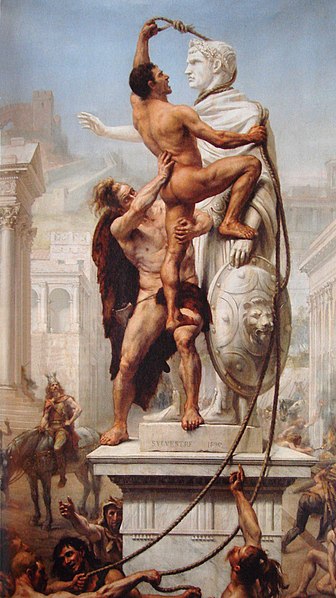 |
| Romanticized Depiction of Goths |
As influence and power moved eastward and the Byzantium capitol became preoccupied with Persian wars, a greater dependency was placed on mercenary troops in the West. Germanic mercenary “Auxiliaries” forces employed by the Empire would, over time, become a contributing factor to further decline as they became subject to capitulation. This was especially true when they went up against invading forces like the Scirii, who spoke their native tongue.
 |
| Theoderic the Great |
Motivation for Self-Rule
By the mid 6th Century, Emperor Justinian would eventually reclaim some Western territory, including portions of Italy, Dalmatia, Africa and Hispania, beginning in the 530s CE. However, these re-conquests were somewhat ephemeral, with control lasting 15 to 25 years per province over a mere 30 years. By Justinian’s death in 568 CE the Eastern Empire would have seceded all claims to the West, intentional or otherwise. By then, Byzantium’s sole economic and military focus would be on the final stages of empire’s seemingly endless conflict with Persia.
Papal Preoccupation
| Council of Nicaea |
Loaves and Fishes
The Gift of Knowledge
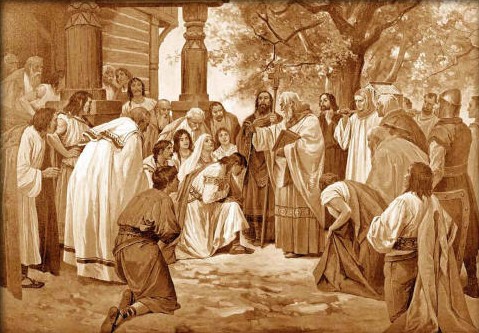 |
| Early Slavic Christian Missionaries |
However, unlike the early apostles, most missionaries at the decline of the western empire were not only literate (go to "Illiteracy and the Spread of Christianity"), they were well educated in both Greek (then the language in the church) and Latin. A typical monastic education would also include, formal training in oration skills, mathematics, astronomy, music, and the study of handwriting, so as to scribe on portable, reusable wax tablets. Monks were also provided a rudimentary education in medicine as well as field training in time-proven medicinal cures, using readily available herbs and roots. Eventually, the cities and towns that were to populate Europe would depend on members of the Church for ideas, innovations and cures, as well as education for public and administrative positions.
 |
| Medieval Bore Hunting |
Feeding the Masses
Today, in the 21st century, one can still discover indigenous communities of Africa, South America and Pacific Islands that depend totally on fishing and game hunting for survival. These peoples live as they did thousands of years ago. They survive in small communities, live in grass huts and share their daily meal while they plan the next day's outing. They are just as intelligent and resourceful as those who live in large, overcrowded urban centers. Yet, their standard of living never improves. The reason they remain stuck in time is because they reside within environments prohibitive to agriculture.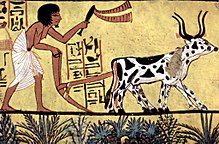 |
| Ancient Egyptian Agriculture |
The Grain of Civilization
Egypt's knowledge of agriculture remains clearly visible within the artwork it left behind, depicting early ploughs amongst assorted grain crops. It was grain storage that freed its population for the time-consuming task of daily foraging. Free time allowed for advancements of the studies, including mathematics and engineering.Early Egyptian granaries fueled the construction of the great Pyramids of Giza, built temples to the gods, palaces for the Pharaohs, while all the time feeding hitherto unknown large land armies to defend and expand the empire.
 |
| Roman Harvesting Machine |
The City of Rome would be built around its own granaries and mills, and import considerable grain from the fertile Nile valley to be stored with its own, enabling its citizens to focus on the largest and most successful market economy society known to the world at that time.
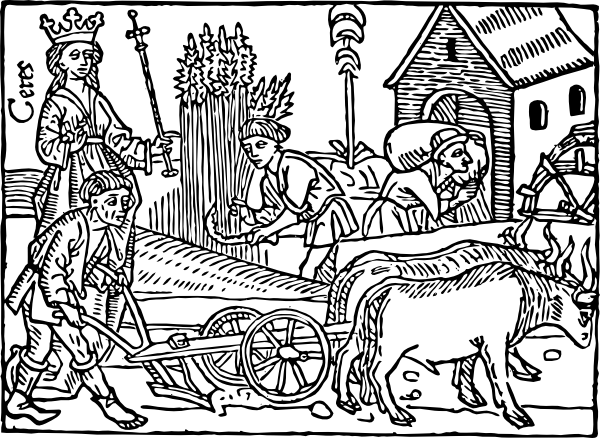 |
| Medieval Farming |
Eastern Decline
The 700 Year War
.jpg/300px-Ancient_Sasanid_Cataphract_Uther_Oxford_2003_06_2(1).jpg) |
| The Game-Changing Persian "Cataphract" |
Throughout the Roman Empire's history, Persia (Parthia/Sassanid Empires) remained a thorn in its side. Issues began with Persia (then Parthia) as far back as 69 BCE, when Lucius Lucullus first invaded Southern Armenia. Military conflict would continue past 629 CE, when Heraclius restored the True Cross to Jerusalem. Hostilities became ongoing after Rome was humiliated in one of its greatest military defeats in 53 BC, when Marcus Crassus and his son were defeated at the Battle of Carrhae by considerably inferior forces. After which, Julius Caesar vowed to subdue the Parthians. Unfortunately for Rome, Caesar was assassinated before he could embark.
Over the resulting 698 years of conflict, Persia and the Roman Empire would be involved in 30 consecutive wars, with little gain for either side. Historians have compared these conflicts to WWI trench warfare, where meters of land were exchanged at terrible costs. Ultimately both Byzantium and Persia would pay the price for prolonged war and wasted resources with weakened governments and border defenses. The resulting bankrupt and exhausted states would then serve as an open invitation to Islamic forces in the seventh century.
Commentary
 |
| Medieval Festival |
Subsequently, the early monks and friars would replace pagan superstitions with proven results, while supplanting the tribal witchdoctors to establish a position for themselves and their church within thriving new communities. They managed it all on their own, without a young and questioning church administration that might have otherwise hinder the progress.
Conversely, having surrendered the western half of the empire along with its tax revenues, the eastern Byzantine Empire continued to decline. The ongoing war with Persia would not permit the Emperor time to contemplate what had gone wrong in the West. If he had, he may have understood that continued conflict and excessive taxation to support a war cannot be maintained indefinitely. In the end, the economically and militarily exhausted empires of Byzantium and Persia would together present an invitation to the rise of Islam.
Go to: Chapter 6) Ongoing Thread of Monotheism
Got Feedback?
Comments? Questions? Corrections? Any feedback at all? Just click on the comments box at the bottom of this page and enter your thoughts. All comments are welcome.
Santuario de Guadalupe, the oil painting by Tom Mallon. This 42" x 22" canvas is the latest addition to the Santa Fe Portrait Series. The Santuario is the oldest shrine to Our Lady of Guadalupe in the US.
Visit this later update by CLICKING HERE
Shostakovich and Cultural Snobbery, Could anyone survive Stalin's Purges, compose a large body, write for himself and the masses while producing constantly great work?
Visit this later update by CLICKING HERE
Also of interest…
Tom Mallon's website "MallonArt". This website will provide you with links to all his paintings, drawings and other artwork portfolios, including the ongoing series entitled the Santa Fe Portrait.
Visit this later update by CLICKING HERE
Santuario de Guadalupe, the oil painting by Tom Mallon. This 42" x 22" canvas is the latest addition to the Santa Fe Portrait Series. The Santuario is the oldest shrine to Our Lady of Guadalupe in the US.
Visit this later update by CLICKING HERE
Shostakovich and Cultural Snobbery, Could anyone survive Stalin's Purges, compose a large body, write for himself and the masses while producing constantly great work?
Visit this later update by CLICKING HERE
Tom Mallon's website "MallonArt". This website will provide you with links to all his paintings, drawings and other artwork portfolios, including the ongoing series entitled the Santa Fe Portrait.
Visit this later update by CLICKING HERE
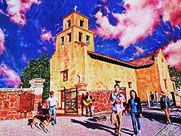



No comments:
Post a Comment